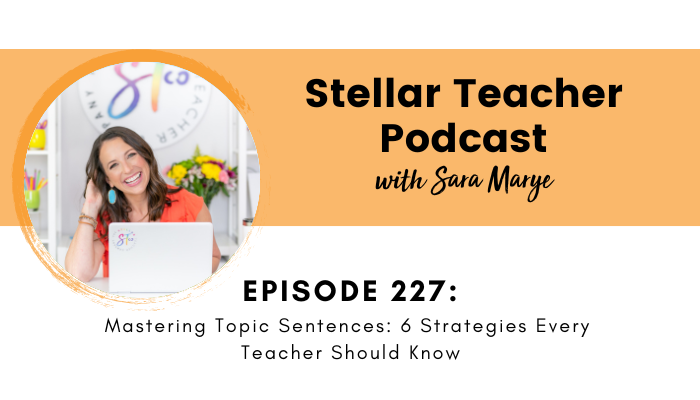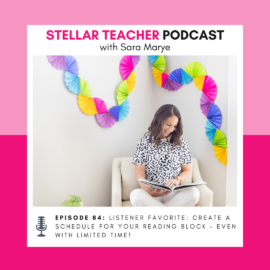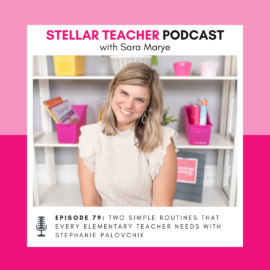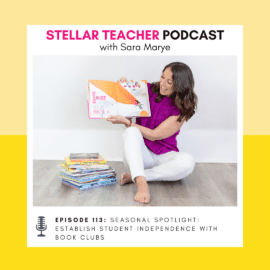
Click play below to hear 6 things you can do to help your students write strong and interesting topic sentences.
If teaching topic sentences has ever felt like a struggle, you’re not alone. Many students find it challenging to start their paragraphs with a clear, engaging main idea, often jumping into details or relying on repetitive phrases. In today’s episode, we’re tackling this foundational writing skill with six practical strategies to help students craft topic sentences that truly enhance their paragraphs.
Reflecting on my own classroom experiences, I remember how often students would freeze at the beginning of a paragraph or produce overly generic topic sentences. Now, with proven strategies in hand, I’m here to share exactly how you can guide your students to create topic sentences that set the right tone and direction for their writing. From structuring their ideas to experimenting with sentence frames, these approaches will make a noticeable difference.
Join me as we explore hands-on activities and techniques, like identifying topic sentences in reading materials and practicing with prompts, that are sure to build your students’ confidence and skill. With a bit of guidance, you’ll see them move from hesitation to mastery in no time! Plus, these strategies will not only strengthen their topic sentences but also enhance their overall paragraph writing, helping them create clearer, more cohesive paragraphs with ease.
In this episode on topic sentences, I share:
- The importance of ensuring students have a solid understanding of the general structure of a paragraph.
- How students can benefit from engaging with actual writing examples.
- Ways to scaffold lessons on topic sentences to best support your students.
- How creating an outline first can help students craft their topic sentences.
- Tips on effectively teaching students how to write strong topic sentences.
- How mastering the writing of topic sentences can improve paragraph writing.
Resources:
- Join The Stellar Literacy Collective
- Sign up for my Private Podcast: Confident Writer Systems Series
- Sign up for my FREE Revision Made Easy email series
- If you’re enjoying this podcast, please leave a review on Apple Podcasts!
Related Episodes:
- Episode 208, 5 Steps to Better Paragraph Writing in Upper Elementary
- Episode 186, Don’t Let Grammar Be the Star of Your Writing Block! Do This Instead.
- Episode 142, How to Get Students to Write a “MEATY” Paragraph
Connect with me:
- Join my newsletter
- Shop my TPT store here
- Instagram: @thestellarteachercompany
- Facebook: The Stellar Teacher Company
More About Stellar Teacher Podcast:
Welcome to the Stellar Teacher Podcast! We believe teaching literacy is a skill. It takes a lot of time, practice, and effort to be good at it. This podcast will show you how to level up your literacy instruction and make a massive impact on your students, all while having a little fun!
Your host, Sara Marye, is a literacy specialist passionate about helping elementary teachers around the world pass on their love of reading to their students. She has over a decade of experience working as a classroom teacher and school administrator. Sara has made it her mission to create high-quality, no-fluff resources and lesson ideas that are both meaningful and engaging for young readers.
Each week, Sara and her guests will share their knowledge, tips, and tricks so that you can feel confident in your ability to transform your students into life-long readers.
Tune in on your favorite podcast platform: Apple, Google, Amazon, Spotify, Castbox, and more! If you’re loving this podcast, please rate, review, and follow!
Podcast (stellar-teacher-podcast): Play in new window | Download
Hey there, Stellar Teacher! Thanks so much for tuning in to today’s episode. We’re going to jump right in, and I have a question for you. Do you ever feel like teaching something should be so much easier than it is in reality? Maybe you see an objective on your lesson plan or a list of standards, and when you’re planning, you’re like, “Oh, this is going to be so quick and easy to teach. I’ll dedicate 10 minutes to this on Thursday, and we’ll be good to go.” But then you realize that you were incredibly wrong because, whatever it is you’re trying to teach, your students just don’t seem to get it. And because you thought it was going to be so simple, you haven’t prepared enough examples, enough practice, or thought through the right type of scaffolding you need to put in place, and your students end up floundering.
I definitely felt that way when I would “teach”—and if you could see me recording, I’m putting “teach” in air quotes— because I don’t think I did a very good job. When I would teach my students how to write topic sentences, and when I think about this objective in my head, it should be such an easy one to teach. It’s just one sentence that communicates the main idea of the paragraph. It’s so general, it seems so straightforward, that it should be simple. Yet, my students always seemed to struggle with writing topic sentences. Often, I would get topic sentences that would be better suited as a detail in the body of the paragraph. They missed the idea that a topic sentence needs to be more generalized and include the main idea. They would try to jump right in and share a supporting detail.
I would also get topic sentences that were poorly written. Not necessarily that they were incomplete sentences, but just very generic way to start their paragraphs. For example, I would see, “In this paragraph, I’m going to tell you why dogs make great pets.” It was as if my students didn’t understand how to write a paragraph without saying, “In this paragraph, I’m going to tell you…” I also found that many of my students could write supporting details much more easily than they could write topic sentences. But since topic sentences come first in the paragraph, they felt paralyzed and would spend a lot of their writing time just staring at a blank page, unsure how to start. Even if they could articulate – This is what I want to say. These are my supporting details. – they didn’t know how to make a generalization that encompassed all those details.
I would try to help my students by modeling and even by suggesting different ways they could start their topic sentences—like sharing an interesting fact, starting with a quote or some dialogue, or with strong emotion or a strong opinion. But even with these starting points, it didn’t seem like enough support to make them feel confident in creating a solid topic sentence.
So, as I’m sharing my experience from when I was in the classroom, I’m curious—does any of this resonate with you? Since leaving the classroom, I’ve learned so much more about what effective writing instruction looks like. I have a much better understanding of why my students struggled with topic sentences, and I have many more strategies I could have—and really should have—used to support them in becoming skilled writers.
That’s what we’re going to talk about in today’s episode. I’m going to share several strategies that can help your students become more confident in their ability to create strong topic sentences.
Before I do that, let me extend an invitation. I know that teaching writing is a challenge for upper elementary teachers. I felt that challenge when I was in the classroom, and we hear from so many teachers in our audience who feel they struggle with teaching writing. If that sounds like you, let me invite you to join us inside the Stellar Literacy Collective. This is our membership for third, fourth, and fifth-grade teachers. One of the things our members love most about our membership resource library is our exclusive Paragraph Writing Routine. It takes the guesswork out of teaching paragraph writing by giving you and your students a step-by-step process for writing a coherent, detailed paragraph. Plus, it includes lesson plans and ready-to-print student materials. One of our members, Laura, has shared repeatedly how the bite-sized steps in our routine have helped her reluctant and struggling writers make significant progress. She has seen so much progress in their actual writing and their confidence as a result of using this routine.
The doors to the membership are currently open, so if you’re interested in a much easier and more supportive approach to paragraph writing for your students, you can learn more at stellarteacher.com/join. And, of course, we’ll link to that in the show notes.
Now, let’s dive into six strategies that can help your students write stellar topic sentences.
First, ensure that your students have a solid understanding of the general structure of a paragraph. You might be thinking, “But wait, I thought we were talking about topic sentences.” And we are! But in order for students to plan and write a strong paragraph, they need to be confident in their ability to identify and produce the types of sentences included in a paragraph, including topic sentences. For students to write great topic sentences, they need to know the difference between a topic sentence, a supporting detail, and a concluding sentence. Essentially, students need to understand the structure of a paragraph and the function of each sentence within a paragraph. That way, it is going to be easier for them to actually produce these sentences.
At the most basic level, we want students to understand that a paragraph is a group of sentences that includes details that support a single main point, and most paragraphs are going to have three types of sentences. We want them to know that most paragraphs begin with a topic sentence—a statement of the paragraph’s main idea. It’s also important for them to know that there are many different ways to structure a topic sentence to communicate the main idea, so there isn’t just one single way to write a topic sentence.
We also want students to understand that the majority of the sentences in a paragraph will be supporting details. These are the sentences that share facts, examples, descriptions, or explanations. They are the sentences that give pieces of information that really help explain, or prove, or strengthen the main idea shared in the topic sentence. These sentences help the reader understand why the main idea is important. It’s crucial for students to understand how supporting details can have facts, examples, descriptions, and explanations – that those things are included in supporting details. Those things are not a part of a topic sentence. We want to make sure that students really understand the different attributes of the types of sentences, so they know what to include in their topic sentence and what to not include.
We also want students to know that most of the time, the last sentence in their paragraph will be a concluding sentence, which restates the topic sentence or summarizes the supporting details they shared in their paragraph. Students need to understand these types of sentences. They need to understand the attributes and functions of each sentence type and the usual order within a paragraph, so they feel confident replicating them on their own. Writing a strong topic sentence starts with understanding paragraph structure.
Specifically thinking about topic sentences, a great way to help students improve their topic sentence writing skills is to have them identify topic sentences in paragraphs they’re reading. This isn’t even a writing task; it’s more of a reading and categorization task, but it will help your students improve their ability to write strong topic sentences.
Students benefit from seeing actual writing examples. I think sometimes we feel rushed, and we want to just jump right into the writing process before we’ve shown students enough examples of what a specific type of writing is going to look like. To help your students understand the types of sentences in a paragraph, you can take a paragraph from a science or social studies text or create one yourself, separate out the sentences – you can rewrite them on a sentence strip or cut them apart if your paragraph is large enough – then mix them up so they are out of order. So students know that all of these sentences belong in the same paragraph, but they’re not in the right order. Then we want our students to identify which one is the topic sentence. Having them practice identifying the topic sentence from a mixed-up paragraph is a really great activity, especially if you’re first introducing topic sentences, because it’s going to help students recognize how topic sentences are different from supporting details. They’re going to start to create a separation in their head of the different types of sentences. The students are also going to have to pay attention to transition words and context and the structure of sentence so they can tell the difference between the topic sentence and the concluding sentence, because oftentimes those sentences are similar, since they both communicate the main idea, but the way we structure them is different. But in addition to this, students are also seeing examples of how topic sentences could be written. So when we give them an example, especially if it’s a really well written example, they can file that away and possibly emulate that or copy that in their own writing. So a really great scaffolded activity is before you have students even write their own topic sentence or even any sentence in a paragraph. Give them practice first identifying from a paragraph that is already written. Like I said, this is a really great way to scaffold the writing process.
Now, another thing that you can do before you have students write their own topic sentences for their own writing is to have students write a topic sentence or give them practice writing for a paragraph that is not their writing assignment. So if you’re trying to get them to write a paragraph on what makes the best pet, their favorite restaurant, or they’re summarizing a text—whatever it is—we’re going to have them practice writing topic sentences for another paragraph. And again, this will just give them the ability to practice writing this very specific type of sentence.
You can give students a paragraph that is missing the topic sentence, or you could give them a set of sentence strips that have related details on them, and we’re going to ask them to write a topic sentence for these details that you’ve provided. Again, this is another great activity because it gives students practice writing just a single sentence, so it’s not as cognitively demanding as writing an entire paragraph. We’re also giving students practice writing generalizations, which I think is one of the most difficult parts of writing a topic sentence. Like I said in the beginning, for my students, it was always easier to write a detail than it was to write a main idea or the topic sentence, because they have to come up with a generalization. So we’re just going to give them a lot of practice with creating topic sentences and writing generalizations.
And I know I’ve mentioned this a little bit before, and I’ve talked about it on the podcast before, but writing is a cognitively demanding task. Anything we can do to help our students become successful writers while reducing that cognitive load for certain writing assignments will really boost their confidence. So think about it. If your goal is to get students to really understand the role of a topic sentence and to produce a strong topic sentence, then we want to set them up for success. If your students have to come up with the details for their paragraph in order to write a strong topic sentence, now their mental energy is split between creating supporting details and writing topic sentences, and the way we write those two types of sentences is completely different.
When you’re first introducing the idea of a topic sentence to your students, you can provide a little more scaffolding by giving them the details of a paragraph, and maybe even a concluding sentence. This way, the only thing they’re focusing on is coming up with a topic sentence. If they do this a few times, they’ll feel a lot more confident in their ability to write a topic sentence for their own paragraph when it comes time for them to write supporting details as well. So again, another great activity to scaffold their understanding of how to create a topic sentence.
So, obviously, at some point, we want them to actually be writing their own topic sentences for their own paragraphs. Something you can do before they focus on their own topic sentence is to make sure they have a strong outline and a plan for their paragraph. This is something I didn’t do a very good job of when I was in the classroom, which is why I think we’ve made it a big priority inside our paragraph writing routine, which is inside of SLC, because we know how important it is. A lot of times, my students would, in general, have their topic or maybe a bubble map, but they didn’t have a specific plan for their paragraph.
For students to be able to come up with a topic sentence, they really need to know what supporting details they plan on including. Since they’re coming up with a generalization, they need to have the details they’re going to use to create the generalization. So if you have your students take time to create an outline—which might just list out the main idea or focus of their paragraph as a single word or short phrase—and then list out the supporting details in the order they want to share them, again as a single word or phrase, or include symbols or drawings, it’s going to be so much easier for them to look at the outline of their paragraph and come up with a strong topic sentence that has a very connected generalization because they know exactly what they’re trying to accomplish with their paragraph. And like I said, we often either encourage our students to jump right into the writing process or we forget the steps, so our students start writing without taking enough time to plan. Make sure your students know how to plan their paragraph before they start writing a topic sentence.
One of my favorite ways to help students write strong topic sentences is to give them specific examples or sentence frames they can use in their writing. This is different from, at the beginning, when I mentioned including a strong emotion or sharing a quote or an interesting fact. This is different because we’re giving them the actual sentence structure of how they can set up their topic sentence. When your students are first getting started, especially if they struggle, the more support we can give them, the easier it will be for them to succeed. Since the topic sentence is an important sentence, we want to make sure our students know how to structure it to set up their paragraph for success.
You can teach your students a variety of ways. Three ways we really encourage teachers to teach their students how to come up with a topic sentence that has to deal with sentence structure, which are included inside our paragraph writing routine, are: 1) writing a topic sentence that asks a question. For example, “Have you ever wondered why some books captivate us more than others?” We’re giving them the actual structure of the sentence. 2) Have students write a topic sentence that includes an appositive, which is a phrase that gives us more information about the noun. For example, “Reading, a skill that opens up new worlds, is essential for every student’s success.” Again, we’re telling them how to structure their sentence. 3) They can write a topic sentence that starts with a subordinating conjunction. For example, “Although reading can sometimes be challenging, it is one of the most rewarding skills to develop.”
We’re giving them the actual sentence structure, so it’s easier for them to copy that structure with their specific topic and details. Teaching students to write different types of topic sentences gives them more tools and options to include variety in their writing.
My final suggestion, or strategy to help your students with topic sentences, is to have them practice writing more than one topic sentence. We want our students to get in the habit of writing more than one topic sentence. This will give them more practice and force them to use different sentence structures in their writing. When your students are drafting their paragraph and they’re at the step where they’re writing their topic sentence, teach them to write more than one topic sentence and then pick the best one.
Because the topic sentence is so important, we want to encourage students to take their time with this part of the paragraph. You can tell students that when they’re working on their topic sentence, they should come up with three options and then select the best one. This encourages students to slow down and not just rush to finish their writing. It also encourages them to be a bit more creative and try different sentence structures—maybe using those three different sentence types I shared in one of the previous strategies. They’ll also be reminded that sometimes our first idea isn’t always the best option when it comes to writing. This process helps them naturally get into the habit of trying three different things to see what works best.
I’ve just given you six things you can do to help your students improve their topic sentence writing skills. Let’s quickly review them. First, make sure they understand the types of sentences in a paragraph, including topic sentences. Give them practice identifying topic sentences in a mixed-up paragraph. Give them a set of related details and have them come up with a topic sentence, so they practice writing topic sentences outside of their own writing. Then, make sure we’re helping our students create a strong outline for their paragraph before they start writing their topic sentence. We’ll also give them different frameworks for structuring their topic sentence, including using questions, appositives, and subordinating conjunctions. Finally, prompt our students to write more than one topic sentence for their writing.
The cool thing is that all of these ideas will not only help your students improve their topic sentences but also enhance their overall sentence writing and paragraph writing abilities. You don’t have to do all of them to experience some of the benefits. I’d encourage you to pick one or two of these and try them in your classroom this week. Start implementing these with your students. And, of course, I would love to know how this episode helps you and your students. If you found this episode helpful, send us an email at [email protected] or reach out to us on Instagram @thestellarteachercompany, and let me know which of these ideas you’re going to bring into your classroom and how it goes.
I hope you have a great week, and I’ll see you back here next Monday.








Leave a Comment
You must be logged in to post a comment.